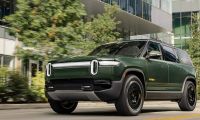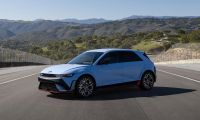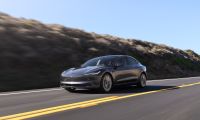Then Ford's EcoBoost F-150 came along, and conventional wisdom began to change. Ford's EcoBoost V-6 was the first turbocharged gas engine offered in a mainstream pickup truck in years, and consumers bought them in droves. Today, Ford has sold hundreds of thousands of trucks with a turbocharged V-6 in place of a standard V-8. This shift in the market - combined with a significant increase in federal fuel economy requirements - likely means that most pickup truck manufacturers will follow Ford and introduce turbocharged V-6 engines in the next few years.
The Turbo-Charged V-6 Truck That Changed the Industry
When rumors of turbo-charged V-6 F-150 began to surface, many people questioned whether these engines would have sufficient performance for towing and hauling. While a turbocharger can greatly increase an engine's output, turbos have a tendency to lag. Turbo lag leads to a distorted torque curve, where an engine doesn't begin to generate serious torque until a few seconds after the driver hits the gas pedal. In a car, turbo lag is a bit annoying. But in a truck (particularly one pulling a trailer), turbo lag can be downright dangerous.
Yet Ford's EcoBoost equipped F-150s have done great. Offering the same type of power truck owners expect from a larger V-8, the EcoBoost V-6 has a better fuel economy rating and only a slightly higher cost. What's more, millions of miles of use have shown Ford's EcoBoost V-6 to be generally quite reliable. Today, Ford boasts some impressive stats:
• Retail registrations of light-duty trucks with V-6 engines grew more than 600 percent, largely as a result of Ford's new engine
• The EcoBoost V-6 represents 45 percent of F-150 pickup truck sales – the EcoBoost is the best-selling engine in the Ford truck lineup.
• More than 56 million gallons of gasoline have been saved as a result of Ford truck customers choosing an EcoBoost V-6 over a standard 5.0L V-8
Ford has so much confidence in turbo V-6 truck engines that they've going to go even smaller in 2015 - Ford is going to offer a tiny 2.7L EcoBoost engine in their 2015 F-150. That's an incredibly small displacement for a full-size truck, especially when you consider that it's only slightly bigger than 4-cylinder engines offered in the Toyota Tacoma and Nissan Frontier.
The Rise of The Turbocharger and A Cloudy Future for The Standard V-6 and V-8
When you look at Ford's success with the EcoBoost, it's logical to wonder if Ford will drop the standard V8 at some point in the future. After all, Ford has already dropped the V-8 on the Expedition (all 2015 Expeds will have a 3.5L EcoBoost V6), and upcoming fuel economy standards are pushing manufactures to adopt more fuel efficient engines. Rumors are swirling that Fiat Chrylser will create a turbocharged version of their new Pentastar V-6 engine in the near future, an engine that could likely replace or supplant the Ram 1500's 5.7L HEMI. Ford's new "Nano" 2.7L V-6 is likely to replace the existing 3.7L V-6 (which is naturally aspirated).
Toyota might join the turbo bandwagon as well, only they'll likely start by eliminating the standard V-6 rather than the V-8. The recently announced Lexus LF-NX crossover will debut with a turbo-charged 4cyl engine – a first for Toyota. Rumor has it that this engine will make it's way into an updated Tacoma in the near future, replacing or supplanting the existing 4.0L V-6. There are rumors of a turbo V-6 engine making it's way into General Motors pickups as well.
Of course, it might be premature to predict the death of the naturally aspirated V-6 or V-8. Toyota plans to make extensive use of their Atkinson cycle/variable displacement engine technology, which essentially allows a standard V-8 or V-6 to behave like a much smaller engine. This technology offers a lot of the benefits of turbocharging without the increased complexity or expense, and it seems like a natural fit for the Tundra.
However, outside of Toyota, the future of the naturally aspirated V-6 and V-8 pickup trucks is up in the air.
Don't Forget Diesels
Nearly all modern diesel engines have turbochargers, and that makes them part of this discussion as well. Ram's new 3.0L V-6 diesel seems to be a big hit with Ram 1500 buyers who might otherwise have chosen a large 5.7L HEMI V-8. GM's 2015 Chevy Colorado will offer a highly anticipated 2.8L Duramax turbo-diesel, which will compete head to head with a 3.6L gas V-6. It remains to be seen if consumers will opt for the baby Duramax over the traditional V-6, but there are certainly reasons to suspect that consumers will like the diesel more.
When you add it all up, it seems relatively certain that naturally aspirated V-6s and V-8s will be competing with turbocharged 4-cylinders and V-6s, as well as diesels. While trucks equipped with naturally aspirated V-6s and V-8s will have a lower asking price, turbocharged alternatives with smaller displacements (and diesels) will offer better fuel economy (and therefore lower operating costs). Toss in government fuel economy regulations that become increasingly stringent year after year, and there's plenty of reason to wonder if the naturally V-6 and V-8 pickup is headed for extinction.












Comments
So long as they can do it
Permalink
So long as they can do it cheaply. When buyers can get an F-150 with the 5.0L V8 at a better price than they can get the EcoBoost V6.. it's obvious why the EcoBoost isn't dominating F-150 sales..
Aaron, did you not read the
Permalink
In reply to So long as they can do it by Aaron Turpen
Aaron, did you not read the article? It says that the EcoBoost is dominating F-150 sales. "the EcoBoost is the best-selling engine in the Ford truck lineup."
Yes and that line is
Permalink
In reply to Aaron, did you not read the by Rob (not verified)
Yes and that line is completely wrong. It's from Ford's own press release on the EcoBoost reaching 400k sales. Yes, the EcoBoost is 45% of sales, but only of V6 sales, not overall sales, and only for the past few months (at most). Consider this.. 400,000 EcoBoost engines since 2011, yet the F-150 has sold 2.32 million units (681k, 752k, 886k in 2011, 12, and 13). 45% of 2.32M is 1.04M, not 400k.
This is not Tim's fault or Patricks (he wrote a similar story a week or so ago). It's Ford's PR's fault. They failed to specify the time period for the 45% of sales in their press release.
I wish to show some
Permalink
I wish to show some appreciation to you just for bailing me out of this challenge. Appropriate following browsing by way of the internet and obtaining principles which were not beneficial, I believed my life was more than. Existing minus the strategies to the difficulties you've got fixed via your posting is actually a crucial case, and the ones that would have badly affected my career if I hadn’t discovered your
Well I'm almost wanting to
Permalink
Well I'm almost wanting to sell my 2013 5.3 vortex Chevy Silverado 1500 z71 its terrible on fuel like 11 to 13mpg at 70/ mph and get ecoboost they got more power then my 5.3 and get better mpg maby all of us GM guys should all go buy ecoboost fords then maby GM will get there heads out of there asses GM better do something soon or I'm going to by ecoboost and ecoboost engine sounds really go 3inch turbo back straight pipe they almost sound like a Cummins